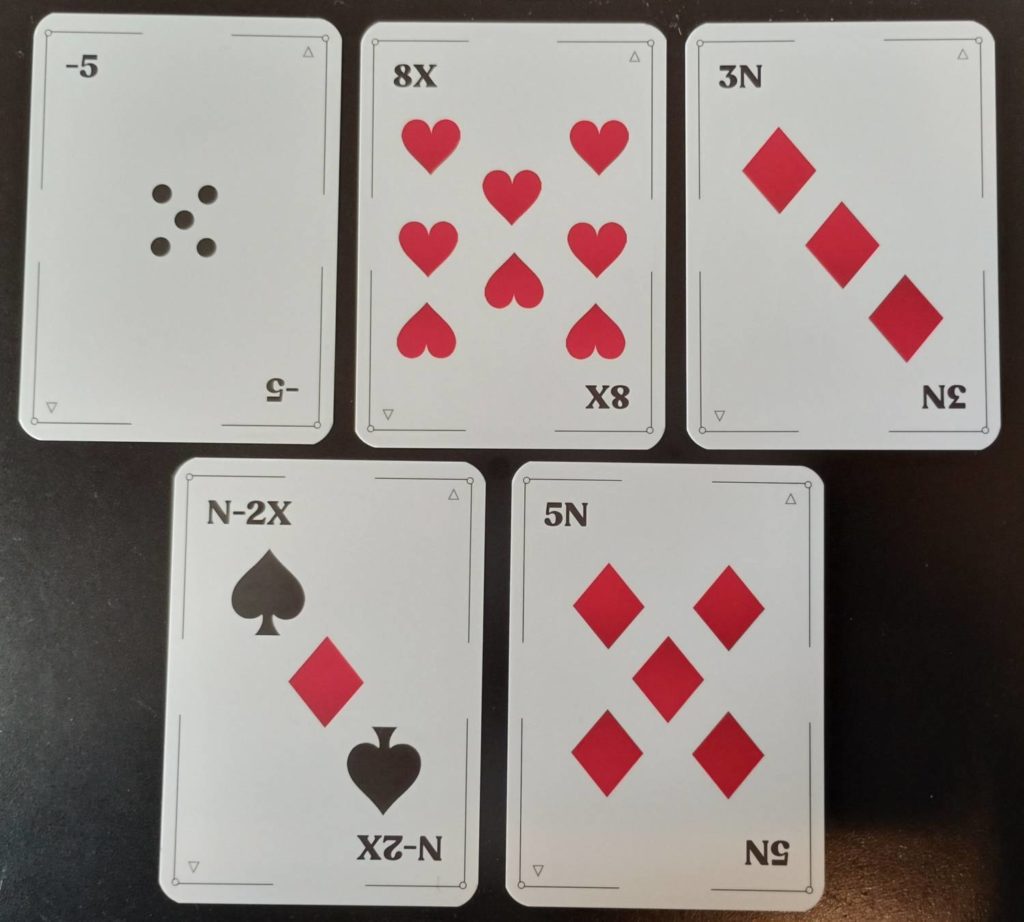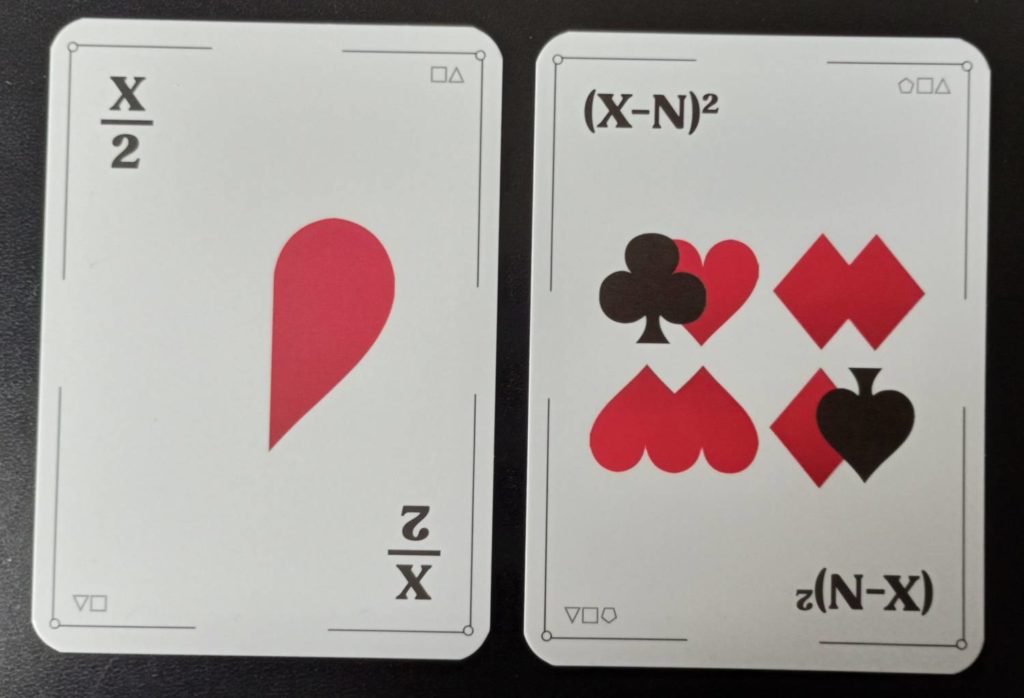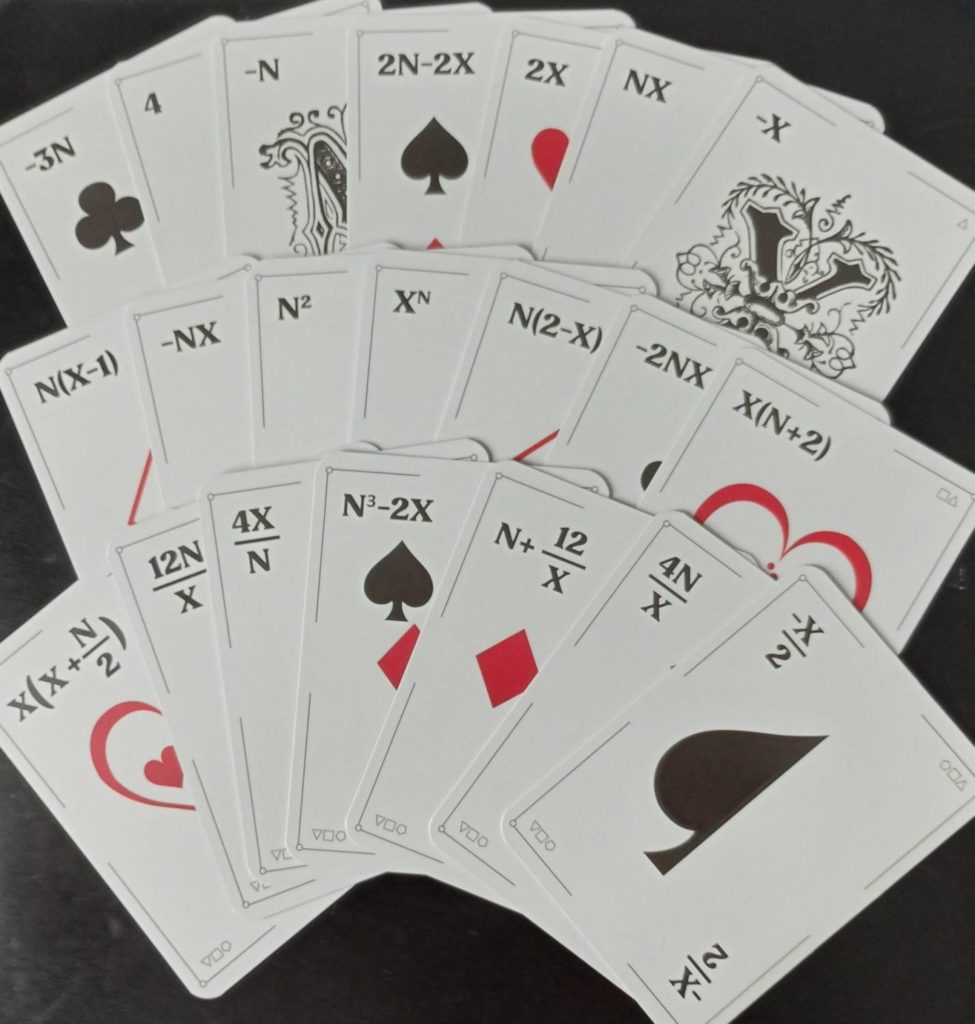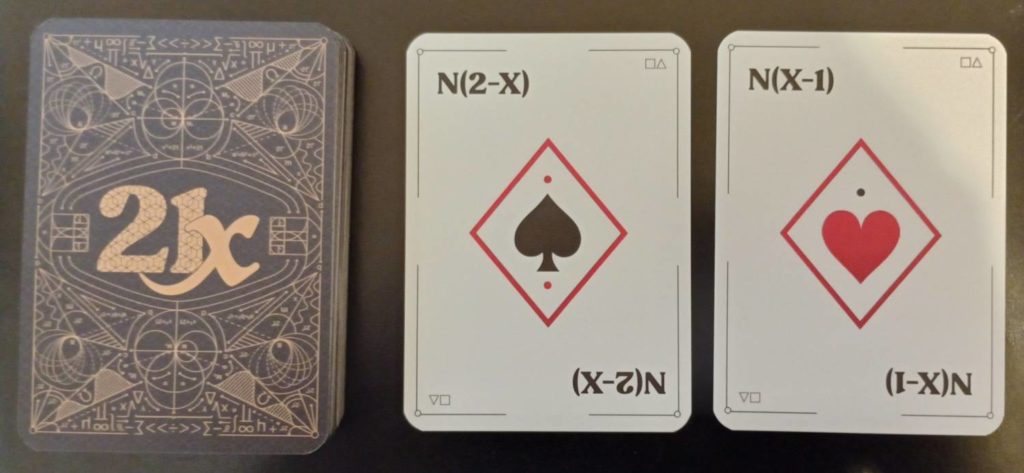Disclosure: Meeple Mountain received a free copy of this product in exchange for an honest, unbiased review. This review is not intended to be an endorsement.
Every now and then something lands on my desk that charms me completely. Something irresistibly playful, smart and altogether beautiful. Something I can’t help but pore over, a fidget spinner for the mind.
Let me tell you about 21X.
Algebraic Blackjack
The goal of 21X is to get as close to 21 as possible without going over. Each round you receive two cards, the value of which might be fixed or could be determined by the number of cards you have (N) and/or an integer of your choosing (X).
You might be dealt these cards:

The total value of these cards is (-5 + 8X), but since you can choose the value of X you have some flexibility. If X is 1 then your total would be 3. If X is 2 then it’s 11. With 3 you’re up to 19 and might call ‘Stick’, challenging your opponents to beat your score within a minute. But that leaves you open to someone else reaching 21 in that time so you might instead ‘Twist’ and take another card.

Since you’ve got three cards, N equals 3. So, with -5 and 9 (3N) you’ve a subtotal of 4. If you change X to 2 then you reach a total of 20. Sadly though, just like in real Blackjack, you can’t ‘Stick’ on 20 so you decide to ‘Twist’ again.

N is now 4. Trying X as 2 results in a total of 23, more than 21 and therefore ‘Bust’. X must now be 1, giving you a total of 17. It’s worse than what you started with but X can be negative so perhaps another ‘Twist’ might help…

The best you can do is 16 (X = -4) which is worse than before you took a fifth card and significantly worse than what you started out with.
At this point, aware of your own mental limitations and thankful that the rules don’t allow you to go beyond 5 cards, you call ‘Stick’ and then lose when someone manages to get 18 within a minute.
Of course, that example just uses cards from Level 1. To get the most out of 21X you should shuffle the Levels 2 and 3 difficulty cards into the deck, introducing divisions, powers and brackets. For example:

The best I can manage is 19 and, honestly, I’d ‘Stick’ every time. ‘Twisting’ might give me something as simple as that -5 we saw before, or it might produce a Level 3 monster like 1 + X(N-2).
There’s flexibility to make 21X as complex or simple as you’d like with the three difficulty Levels of cards, allowing the use of pen and paper and even permitting X to be a decimal number.
Problem Pontoon
If anything about the above examples got even a small part of your brain tingling then you’ll probably enjoy playing about with 21X.
And ‘playing about with’ is the key phrase here.
As a game it’s fine. At its core, though, 21X is still a game of being dealt cards at random and trying to reach the vaulted 21. Some deals are just better.
The timer and competing calculations pep up Blackjack’s dullness, but they also compromise what is, for me, 21X’s prime attraction. Rather like how Scrabble prioritises letter worth over word length or complexity, 21X rewards your ability to quickly ‘Stick’ at a number between 17 and 19 (assuming you can’t hit 21 dead on). Had I actually received -5 and 8X in a game I would have called ‘Stick’ within the first 15 seconds and then spent a slightly embarrassed minute watching my opponents struggle to navigate a route through their cards.

No card is too strenuous by itself, but the combination of two or more of the harder cards quickly fries the noodle. Winning a round with Level 3s feels a whole lot more impressive than with Level 1s but there’s nothing that acknowledges that in the scoring (a possible house rule could score the difficulty of your first two cards). It means winning doesn’t always feel fair, especially if there’s even a slight difference between players in mental arithmetic ability.
Honestly though, 21X isn’t really about the winning. It’s more about personal satisfaction, in the same way that contestants in the British TV show Countdown are really just competing for the quiet gratification of a teapot.
Variable Vingt-un
So sure, as a game it’s fine. A quirky way to spend time with some friends in mostly silent contemplation. A curiosity but not something about which you’ll tell stories afterwards. When someone calls ‘Stick’ you’re racing to beat their number, but it’s a race in which you just put your head down and think harder. I’ve never felt my heart rate increase by even a single beat.
As a play thing, however, 21X is outstanding.
I’ve taken to keeping 21X on my desk, dealing myself a hand anytime I need a quick break. A couple of invigorating minutes calculating and I’m ready for the next chunk of work. I’ve had multiple 21X breaks throughout the process of writing this review.
The best moments of 21X, whether playing it as a game or just messing about by yourself, are when those cards are flipped and the bones of an equation fuse together. Each deal of the cards is a new challenge, a series of arithmetic paths and dead ends to uncover. It’s utterly compelling. I can see the little puzzles that 21X sets being featured in the back of a newspaper, a Wordle-in-waiting.

It’s the perfect example of why tabletop games survived the digital revolution. For those looking to test their algebraic ability, mathematical puzzles along these lines can be found easily enough. But the physical presentation and the act of flipping cards add something more. It helps that the cards are handsome: tactile, abstract and intriguing. The formulae present a solid mix of mathematical approaches to test all brain-types and numerical variants are scattered through the deck, those beautiful illustrations mimicking their algebraic spouses.
I’d love to see these wonderful cards incorporated into a game that actually deserves them, a game that rewards your mental gymnastics and doesn’t hamstring its smarts with the flip of a card. Something like Sleeping Queens or its sequel, games where you create formulae to produce numbers with which to claim stuff and win. Or like Lovelace & Babbage, which has shown just how fun real-time maths can be for those who enjoy mental arithmetic.
Of course, in the end, not everyone enjoys being mathematically challenged. Friends have winced at my description of 21X. Some folk don’t enjoy maths, some don’t want games to feel like study, whilst others find maths hard and don’t want those shortcomings exposed.
To each their own. For those tingly-brained folk who are intrigued, 21X is a joy to mathematically mess around with. Now excuse me whilst I deal myself another hand…












Add Comment